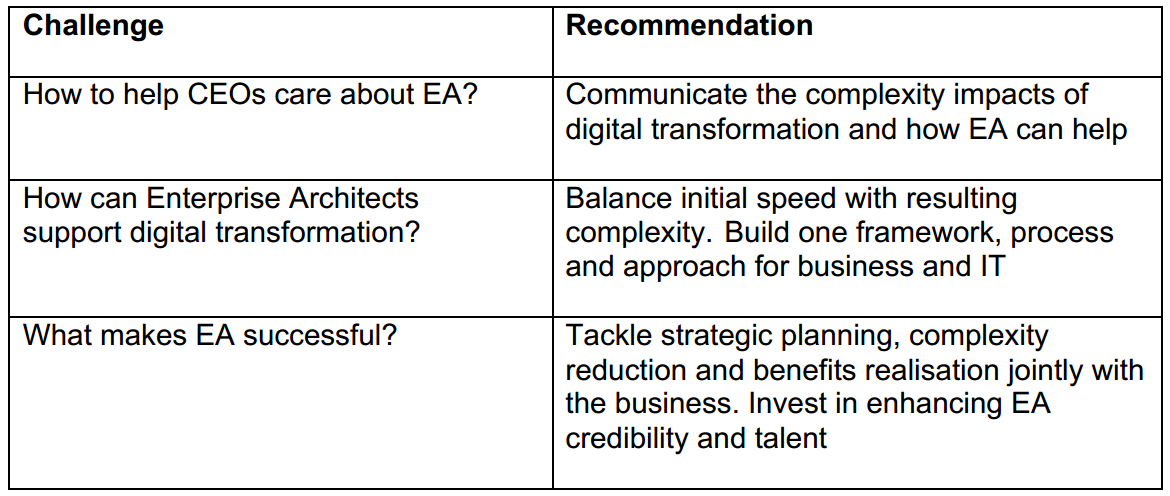It’s a recurrent theme – how can EA leaders engage with the top team – particularly business executives. This article includes supportive findings from the McKinsey & Henley Business School EA Survey. These were reported most recently in a 2017 Journal of EA article ‘Business Value of Enterprise Architecture – Why CEOs should Recognize and Empower their EA Departments’ and presented at the 2017 European EA Conference organized by IRM UK.
![]() Professor Sharm Manwani, Henley Business School, Executive Professor of IT Leadership; sharm.manwani@henley.ac.uk
Professor Sharm Manwani, Henley Business School, Executive Professor of IT Leadership; sharm.manwani@henley.ac.uk
Dr Oliver Bossert, McKinsey & Company, Senior Knowledge Expert; oliver_bossert@mckinsey.com![]()
ABOUT THE EA SURVEY
The EA Survey is an ongoing collaboration between McKinsey & Company and Henley Business School. More than 100 companies globally, from multiple industries have provided us with over 5,000 qualitative and quantitative data points about their EA functions. Through finding best practices and quantifying the value of EA we aim to raise awareness of the importance of the function, whose benefits we have observed in multiple client engagements. Visit easurvey.org to join the effort or contact the authors for more details.
Introduction
This article addresses three questions informed by the McKinsey & Henley EA Survey.
– Why should CIOs care about EA?
– How can EA support digital transformation?
– What makes EA successful?
Why should CEOs care about EA?
Organisation leaders compete for CEO attention so EA messages need to be highly relevant and succinct. One clear connect is digital transformation where CEOs are increasingly taking a lead sponsoring role (up from 31% in 2013 to 46% in 2015 according to a McKinsey survey.
Digital’s role in aiding agility is widely accepted so what role does EA have to play. The EA survey found that while digital brings short-term agility it can soon lead to increased complexity without the right EA. This complexity results in reduced agility due to issues such as integration challenges (43% more point-to-point connections), significantly lower quality of business process documentation, and c.20% lower re-use of services.
In support of the EA role, the survey found that the top two focus areas for EAs are IT complexity reduction and Digital transformation – both at over 60%. The EA survey results below support a dialogue with the CEO and top team on EA’s contributions in these areas.
How can EA support digital transformation?
The EA survey examined the different results when EA contributes to the digital agenda. Architecturally, there was both a very significant increase in services (more than five times) and almost a 20% higher reuse of services. This reflects desired architectural changes which over time have evolved from initially monolithic to increasingly modular1. Having more services and less point-to-point interfaces is a key differentiator for lower integration cost with the EA survey highlighting 50+% integration cost differences due to point-to-point connections, applications and services.
These digital-focused EAs also use artefacts to increase alignment within and across business and IT. There is a 30% improvement in quality of documentation linking business and IT and similarly higher use of capability and process models in assisting both IT and business decision-making. In addition, companies who use artefacts appropriately are more likely to decommission applications, a particular legacy type challenge.
What makes EA successful?
Where they contribute to digital, EAs have a significantly greater role in key stages of the business change lifecycle2. These activities are in strategic planning and benefits monitoring (both about 10% more time spent) rather than, for example within solutions development.
Clearly for EA to be involved in these critical business activities, they need a strong stakeholder engagement. Yet in over 40% of cases, business stakeholders are not really aware of what the EA function does. The impact of this lack of engagement is significant. There is a lower chance of modelling the future, less use of capability and process models for business solutions, less adherence to guidelines, and lower benefits monitoring.
All of this reflects and results in a lack of the right EA talent to cope with business and technology challenges. This is not a problem that can be solved by throwing money at it. The survey found that interesting challenges (90%) and recognition as a valued function (71%) were more important to EAs than monetary incentives (43%).
Summary
We summarise some recommendations to address the challenges.

Clearly if there were easy answers to EA demonstrating value to the CEO, it would not be such an ongoing topic. We believe the EA survey does offer some lessons and that as the survey data expands, these insights will increase. Hence we appreciate and encourage participation from EA and other Business IT leaders.
________________________________________________________________
1: https://www.mckinsey.com/business-functions/digital-mckinsey/our-insights/perpetualevolution-the-management-approach-required-for-digital-transformation
2: See IT Enabled Business Change, Manwani S., Published by BCS
Sharm Manwani is Executive Professor of IT Leadership at Henley Business School, where he directs innovative programs for EA leads, professionals and consultants. He was previously European CIO and responsible for Business Architecture at Electrolux.
Oliver Bossert is Senior Expert on Enterprise Architecture and Technology at McKinsey & Company. Within this role, he applies EA to create and implement digital strategies for organizations in various industries.
Copyright Professor Sharm Manwani, Henley Business School & Dr Oliver Bossert, McKinsey & Company


